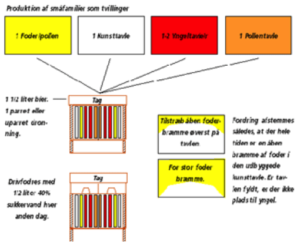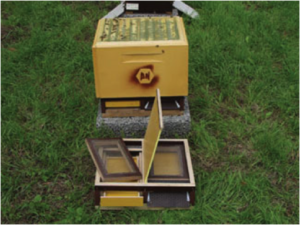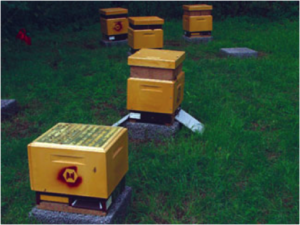Skrevet af: Carsten Wolff Hansen
NUCLEI – NEW COLONIES
SMALL COLONIES ARE AN IMPORTANT PART OF VARROA TREATMENT AND ENSURE NEW COLONIES

With the production of new nuclei, one has more time for varroa treatment, and greater certainty that one decides oneself, how many colonies one has nest season.
When the bees and the queen in newly established colonies produce a mass of brood at the end of the season in order to build a new colony, one utilises the bees reproductive ability in contrast to the varroa mites, and the new colony has the optimal opportunity to produce good winter bees, who can ensure survival and development next season.
This article provides a plan and some advice on how simply and easily one can produce new colonies, and at the same time carry out an effective varroa treatment.
The production of a number of new nuclei ought to be a more natural part of beekeeping than it is today for a great number of beekeepers. Throughout the latter years there has been a great demand for nuclei in Spring. Should one therefore, produce more nuclei than meets ones own needs, they can easily be sold to other beekeepers. One also establishes a good safety net under ones own honey production – and one decides oneself how many colonies one will have.
There are many methods to make nuclei. One can decide on having colonies which will become as strong as normal production colonies, or one can decide on nuclei which over winter in a hive shared with a second colony, and divided by a narrow partition, and where each colony has its own entrance block.
If one makes new nuclei as small colonies, one has extra queens, bees and brood to use in reinforcing colonies that emerge weak in Spring. If one uses a queen from such a small colony, one can without problems unite the now queenless colony with another small colony in Spring, and carry on with them as a normal production colony. There are many possibilities when one has extra colonies, and as stated, one achieves a far greater control over having the desired number of colonies.
HIVES FOR NUCLEI
All sorts of hives can be used for creating nuclei. In some old trough hives there is an extra entrance block at the side of the hive, and if a bee-tight partition is erected between that part of the hive and the original colony, a nucleus can be established at the back of the hive. Trough hives can be rebuilt so that there can be three or four nuclei , each with their own entrance, in a single hive.
Normal hives with special bottoms are the most suitable for nuclei, and here it will be, in most cases, suitable to have one or two nuclei in each hive. It is also possible to have three or four nuclei in each hive, dependent on the size of frame and box.
Nuclei ought to be established on at least three frames, and ideally on five. The five frames make it easier control feeding, without blocking for the queen’s egg laying. Feeding should take place separately for each colony. If several nuclei have access to the same fodder source, problems will easily arise, and the one queen will succumb and the bees will collect around the second queen.
HOW, WHEN AND HOW MANY?
As in all successful beekeeping , one should in good time plan how, where and how many new nuclei one should have in a season. It is, of course,a requirement that one has the number of queens needed. If one buys ones queens, one should have an agreement with a queen producer as to when one wants to create new nuclei. If one produces ones own queens , then it is recommended that one use the first queens for nuclei, since it is often difficult to introduce new queens into established colonies. If one wishes to wishes to increase the number of colonies one has, one can plan to double the numbers. If one wishes to have a safety net under the number of colonies desired, it can be a good idea to make half as many nuclei as the number of colonies one started with. Should it be planned properly, one can, in fact, multiply the numbers of colony in a season.
There are many methods to make nuclei, and in Tidskrift for Biavl (Beekeeping Monthly) there are regular descriptions on how this is done.
NOTES ON VARROA TREATMENT FOR NUCLEI
In relation to varroa treatment in nuclei, two factors are especially important. The first thing one should remember is that sealed brood frames can contain many varroa mites, so therefore both bees and brood frames should be taken from colonies with little or moderate attack of varroa. The second factor is this: if one makes nuclei with virgin queens and sealed brood frames without open brood, it will mean, dependent on mating weather, a shorter or longer period , where there is not sealed brood in the colony. This provides some optimal conditions for varroa treatment with lactic acid, or with oxalic acid. Oxalic acid is, unfortunately, at the time of writing not permitted for this use. If one should prefer to establish nuclei with mated queens, it may be a good idea to spray the bees one is to use with lactic acid initially, and treat the newly sealed brood frames without bees with either lactic acid or heat treatment. Brood about to hatch is sensitive towards these treatment methods and, therefore, they must be newly sealed brood frames. Later, when the nuclei are well established, varroa treatment can be carried out in the normal way.
LET US GET STARTED
In this connection only one piece of advice is offered, which is as sure as it can be, when one is working with bees. Many beekeepers have bad experiences in taking bees and brood frames from the ordinary production colonies. It will weaken them, and one has advanced nowhere if one has destroyed some families in order to establish others. Therefore, on ought to have some colonies which are set aside just for this purpose. The bees that are to be used for nuclei, ought to, if there is a pause in the honey flow, be taken to a new apiary at least 3 Km. from where they came.

